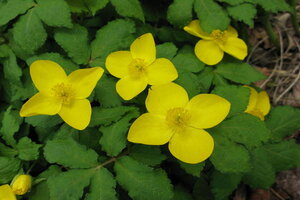Three outstanding spring plants for the shade garden
A trio of woodland wonders thrives in a Midwest shade garden.

Bring sunshine into your spring shade garden with Hylomecon japonica, a small perennial woodland plant.
Courtesy of Betty Earl
One doesn’t have to be a poet to recognize spring as the time of rebirth.
Spend a little time in your garden now watching as plants push skyward toward the warmth of the sun or the buds on the trees bulge with new life until finally they simply burst open in a sea of wondrous color.
Stop and listen. Birds are singing once again, bees buzz hungrily around the first blossoms of the season, and the chorus of the frogs is truly mesmerizing.
Wandering about my Midwest woodland garden after the first flush of color brought on by the minor bulbs of snowdrops (Galanthus nivalis), crocus, winter aconite (Eranthis hyemalis), scilla (Scilla sibirica,) and glory of the snow (Chionodoxas), I find that it’s captivating to watch the emergence of new growth.
Small bulb, big impact
One bulb I would never be without is the grape hyacinth (Muscari armeniacum). Tiny cobalt-blue flowers densely clustered like miniature grapes on a firm vertical stalk, the bottom flowers open first, while those above are smaller and less developed. [See photo at left.]
These flower clusters are long lasting, reseed freely, and form sprawling drifts of green and blue in unexpected places. Large patches are charming naturalized in the woodland garden.
However, they can also drift into the lawn, where their waxy coat protects them from weed killers – causing them to go from charming to pesty in many people’s minds. If you are of the latter mind-set, pinch off spent scapes before the seeds have a chance to mature, thus remedying the reseeding problem.
Two Japanese native poppies
Another early spring heart-throb is one of the Japanese wood poppies – Hylomecon japonica. A herbaceous perennial with light green, lobed to divided leaves, it lights up my woodland garden with its showy bright sun-yellow flowers. [See first photo above.]
It is not often found in gardens (I honestly don’t understand why). Its bloom season is rather brief, it’s true, but to my mind it more than earns its keep by providing a “wow” factor when it blooms.
It's easily cultivated in humus-rich, slightly moist soil in partial shade. I had to move my clumps around a bit until I found a spot they truly liked – a somewhat sheltered area near shrubs. Typically listed as a Zone 6 plant in literature, it now thrives happily in my Zone 5 garden.
Finally, another rare yet highly prized Japanese woodlander, Glaucidium palmatum, has large silky purple-pink or creamy white flowers over full maplelike leaves. [See second photo above; click on arrow at right base of first photo.]
Reaching 20 inches in height and spread, mature plants bloom for approximately three weeks, but the large clump of grass-green leaves adds interesting texture to the summer garden, as well.
Preferring partial to full shade in moist, humus-rich soil, in my garden, this plant (hardy to Zone 4) of exceptional beauty seems to thrive without any extra irrigation on my part.
That said, I did add quite a bit of compost and mulch for moisture retention when I first planted it.
-----
Betty Earl, the Intrepid Gardener, blogs regularly at Diggin' It. She's the author of 'In Search of Great Plants: The Insider’s Guide to the Best Plants in the Midwest.' She also writes a regular column for Chicagoland Gardening Magazine and The Kankakee Journal and numerous articles for Small Gardens Magazine, American Nurseryman, Nature’s Garden, and Midwest Living Magazine, as well as other national magazines. She is a garden scout for Better Homes and Gardens and a regional representative for The Garden Conservancy. To read more by Betty here at Diggin' It, click here.
